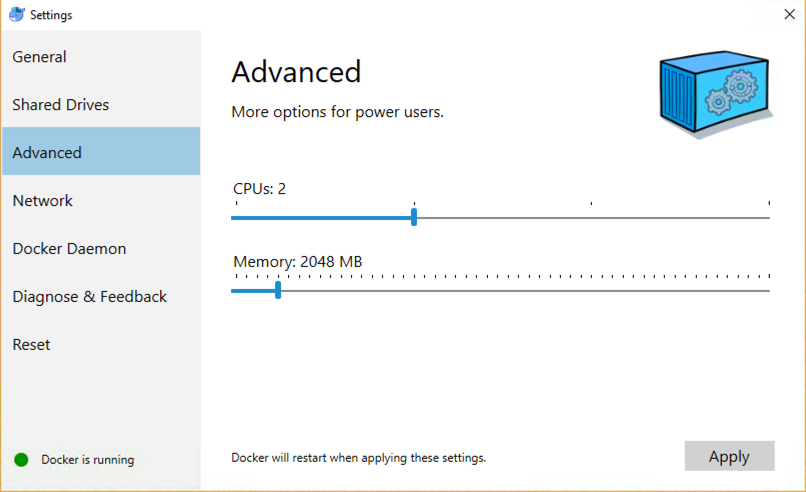Create Dockerfile for client and server each. Create docker-compose.yml file for our app. Build Docker images using docker-compose.yml file. And last, run the Mean Stack app using Docker Compose tool.
The Docker team announced support for running Kubernetes using the Dockerfor Mac application. For a while, it was only available on unstable Edgereleases of the Mac application.
Docker for Mac’s Kubernetes cluster is now available in the stable release channel! 🎉
- In this article I will show a brief overview of a simple docker setup for Go application development. To get started, you need Docker installed in your system. Get the community edition here.
- VSCodeがDockerコンテナのリモート開発に対応したりして潮目も変わってきたので 過激派用の設定も追記しました。 Dockerで立ち上げた開発環境をVS Codeで開く!
This makes running Kubernetes for local development somuch easier. You no longer need to install and run a separate cluster usingsomething like Minikube. (Though, if you need to, I have a guide on installingMinikube on your Mac.)
It's available on Docker Community Edition version 18.06.0-ce-mac70 2018-07-25 or later.
Setting up kubectl with Docker for Mac Kubernetes
Setting up kubectl to use Docker for Mac is simple.
If you don't already have kubectl installed, the easiest way is with Homebrew.
brew install kubernetes-cli- Install the most recent version of Docker for Mac, one that includes the Kubernetescluster functionality.
- Click the Docker menu bar icon > Preferences, then click the Kubernetes tab. Click the checkboxto enable Kubernetes and switch the default orchestrator to Kubernetes. Docker might take a fewminutes to install more components here.
- Docker for Mac will start the Kubernetes cluster. Once it’s running,click the Docker menu bar icon again and expand the Kubernetes menu item. Then under Context, select
docker-for-desktop. This will switch kubectl to thedocker-for-desktopcontext. - Run
kubectl config current-contextin a Terminal window. It should outputdocker-for-desktopif kubectl’s context has updated. - If you’re curious, you can also see the configuration settings that kubectl uses to connect to Docker for Mac’s Kubernetes cluster. Run
kubectl config viewto outputall your available kubectl contexts. (I have a chapter in my book that explains kubectl config in detail)
Running your first Kubernetes pod with Docker for Mac
Once you’ve set up kubectl to use Docker for Mac’s Kubernetes cluster,you can run your first pod!
Create a file called pod.yaml containing the following YAML configuration.
Now run the pod, and then check its status as it gets run on Docker for Mac’s single node cluster
Does this replace Minikube?
I’d expect Minikube to stick around for a while—it’s a much more stable and matureimplementation of a single-node Kubernetes cluster that you can run locallyon your Mac. But Docker for Mac is a great, simple way to run a simple cluster on your local machine. Plus, the Docker menu bar icon gives you a new, fast way to switch kubectl contexts.
-->By Rick Anderson
ASP.NET Core uses HTTPS by default. HTTPS relies on certificates for trust, identity, and encryption.
This document explains how to run pre-built container images with HTTPS.
See Developing ASP.NET Core Applications with Docker over HTTPS for development scenarios.
This sample requires Docker 17.06 or later of the Docker client.
Prerequisites
The .NET Core 2.2 SDK or later is required for some of the instructions in this document.

Certificates
A certificate from a certificate authority is required for production hosting for a domain. Let's Encrypt is a certificate authority that offers free certificates.
This document uses self-signed development certificates for hosting pre-built images over localhost. The instructions are similar to using production certificates.
Use dotnet dev-certs to create self-signed certificates for development and testing.
For production certs:
- The
dotnet dev-certstool is not required. - Certificates do not need to be stored in the location used in the instructions. Any location should work, although storing certs within your site directory is not recommended.
The instructions contained in the following section volume mount certificates into containers using Docker's -v command-line option. You could add certificates into container images with a COPY command in a Dockerfile, but it's not recommended. Copying certificates into an image isn't recommended for the following reasons:
- It makes difficult to use the same image for testing with developer certificates.
- It makes difficult to use the same image for Hosting with production certificates.
- There is significant risk of certificate disclosure.
Running pre-built container images with HTTPS
Use the following instructions for your operating system configuration.
Windows using Linux containers
Generate certificate and configure local machine:
In the preceding commands, replace { password here } with a password.
Run the container image with ASP.NET Core configured for HTTPS in a command shell:
When using PowerShell, replace %USERPROFILE% with $env:USERPROFILE.
The password must match the password used for the certificate.
Note: The certificate in this case must be a .pfx file. Utilizing a .crt or .key file with or without the password isn't supported with the sample container. For example, when specifying a .crt file, the container may return error messages such as 'The server mode SSL must use a certificate with the associated private key.'. When using WSL, validate the mount path to ensure that the certificate loads correctly.
macOS or Linux
Generate certificate and configure local machine:
Using Docker On Mac
dotnet dev-certs https --trust is only supported on macOS and Windows. You need to trust certs on Linux in the way that is supported by your distribution. It is likely that you need to trust the certificate in your browser.
Docker On Mac Os
In the preceding commands, replace { password here } with a password.
Run the container image with ASP.NET Core configured for HTTPS:
The password must match the password used for the certificate.
Windows using Windows containers
Generate certificate and configure local machine:
In the preceding commands, replace { password here } with a password. When using PowerShell, replace %USERPROFILE% with $env:USERPROFILE.

Run the container image with ASP.NET Core configured for HTTPS:
Docker Get Mac
The password must match the password used for the certificate. When using PowerShell, replace %USERPROFILE% with $env:USERPROFILE.